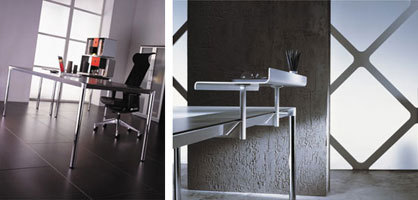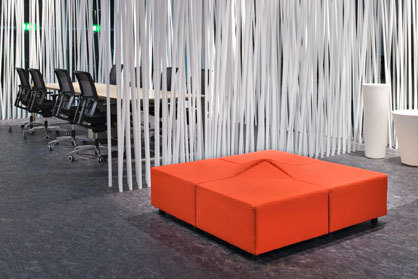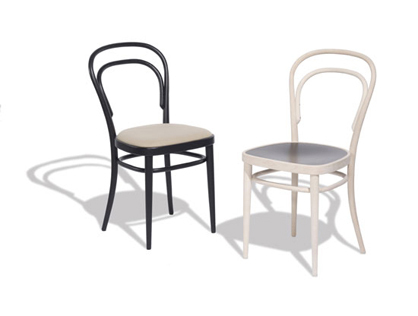What does sustainability mean?
Texte par NoéMie Schwaller
Zürich, Suisse
26.11.08
Sustainability is both a commandment and a buzzword for our times. But what do we mean by sustainable design? Are sustainable production and sustainable marketing at all possible in a global market place? At this year’s Orgatec we discussed the subject with representatives from the furniture industry in an attempt to find out how ‘green’ design is interpreted.
Sustainability is both a commandment and a buzzword for our times. But what do we mean by sustainable design? Are sustainable production and sustainable marketing at all possible in a global market place? At this year’s Orgatec we discussed the subject with representatives from the furniture industry in an attempt to find out how ‘green’ design is interpreted. The reference to long lasting products with a timeless design, a reference which is as popular as it is over-used, is correct but a simplification and only a single cog in the complex clockwork mechanism of real sustainability. What is urgently required , is an international evaluation standard, but we’re still a long way from this. Here are a few opinions from the industry:
Koray Malhan, Brand & Product Manager of Koleksiyon
«1. A product shouldn't be trendy but classic, like the timeless Eames chair which you should still be using after 80 years.
2. All parts should be separable to be recycled.
3. Resources are important. They should come from a sustainable forest without habitat or fauna. Wasting one rainforest tree means wasting millions of years of DNA. Short-term »green« products are just marketing and lead to green destruction.
Our most sustainable product: CALVINO by Studio Kairos is the most sustainable. Because of the construction: all parts are separable, all parts are recyclable. The extended pieces are made of aluminium, which is 100% recyclable. The thin frame uses a special structure that holds together with less material. The pieces are connected by screwing together; all framing is done within two minutes.»
Calvino work table and Calvino accessories by Koleksiyon
Mimi Lindau Rikardsson, CMO of BLÅ station
«Getting right behind a product from start to finish, this is what sustainability means! Local manufacture and distribution are important. It's not enough to launch a green product just because it's trendy and it's what the customer wants, while the rest of your production is rubbish. Sweden thinks ahead. Why does everything always have to be new? For a long time now eco has been anything but dull and dowdy.
Our most sustainable product: the BOO chair
The felt is drawn over the frame. This is a cooperation with Kvadrat and the chairs are also tested by Kvadrat. The felt which is used can be recycled. The felt base carries the eco-Swan label, which means it is manufactured in an environmentally-friendly way. This also absorbs sound – a metal or plastic chair makes a lot more noise. It's modern in design and material. For gluing we use a special adhesive, a mixture of polyester and micro-fibre. This chair is made to 60% from recycled materials and can be fully recycled. Everything is produced in Sweden, which means that no CO2 is required for air transport. We monitor the entire production chain, from design to production. Even small family companies have kept their production in Sweden – we were thinking green and local at an early stage.»
BLÅ STATION stand at Orgatec 2008 with the BOO chair, design: Stefan Borselius, 2008. Received the Swedish Design Award S 2008.

BLÅ STATION stand at Orgatec 2008 with the BOO chair, design: Stefan Borselius, 2008. Received the Swedish Design Award S 2008.
×Alan J. Heller, Managing Director of Heller
«If we (Americans) didn't sell so much shit it would be a better place!
Our whole economic system is: produce, produce, produce!
What we need is a new consciousness. If this (sustainable trend) doesn't last, the world is not going to either.
The material and the aspect of timelessness is essential. One should not be looking for a fancy product. Take the Bellini Chair, it's a classic. This product is recyclable. Everything is moulded out of 100 % pure materials. If we used recycled material it might not be strong enough.
Our most sustainable product: I've never sold our products on the aspect of sustainability.»
Özlem Yalim, Director of Koleksiyon
«All wooden products are sustainable, no plastic moulds. The parquet in stand panels and floor coverings are re-used materials which on the company approach we are fund of using. Leather is a natural and not a harmful material. All our textiles are hand woven and 100% natural. It is modern to use sustainable design. Sustainable furniture should be used in different styles, in different positions so it won't get boring. Furniture is not a fashionable thing. It should be used more than 5-8 years. When the surface is used it gets even nicer. It's not only an environmental factor, but it is also about creating our own environment. We should only buy for the long-term.
Three points which sustainable furniture must have:
1. It should respect the environment.
2. It should be used long-term by different users.
3. Use it, involve it in different functions and value it in different surroundings.»
Kristina Farwing, Marketing Manager of Swedese
«We have the ambition of sustainable design in all objects, production control included. 80% of Swedese’s standard fabrics are eco-branded, and we offer alternative to chrome (e.g.: aluminium, lacquer). We are running both professional test at the National test institute for product durability, and also internal long term usage tests.
Swedese has since the 1960s been a supplier to the Swedish government, its associated companies and organisations, and they have for a long time had sustainable demands. Today many contract buyers, as well as consumers, are very keen on environmental thinking. Durable design is part of what a company has to do.
1. It should be used and kept for a long time.
2. Materials should be recyclable.
3. The material's origin
4. Transport (ways to save fuel)
Our most sustainable product: so far the Lamino chair
It's a classic selling since 1956. It is used in hotels, offices and in private spaces. It has a homely feeling to it and we have been selling re-upholstery material for the Lamino chair for over 50 years. I don't approve of lacquer, it dissolves. The oiled version is very sustainable. Leather has not been able to be eco-branded yet, but in all other cases we use eco-branded fabrics. Foam should become approved eco-branded as well. The wood we use comes from approved sources. If you choose to oil the wood: it is considered more sustainable and can be eco-branded. We leave the option to the consumer, and are pleased to see they are becoming more and more eco-conscious. If you sell to England, their regulations say they need to have everything with extra fire-protection. So you spray chemicals in the foam, which is contradictory.»
Peter Mahler Sorensen, Managing Director of Engelbrechts
«A long useful life, replaceable material and the development of more natural materials than in current products are our sustainability goals.
Our most sustainable product: the Kevi chair»
Burkhard Remmers, Head of International Communications of Wilkhahn
«Long useful life is often used with reference to material. In our case it's a matter of quality and durability. Poor quality products remain poor quality, even if they are green. The longer the useful life and the better the functions of a product, the more sustainable it is. Everything which isn't used is superfluous. The most ecological house is superfluous if there's nobody living in it. We need an increase in sensibility. The worst thing is that there is far too much poor furniture around.
It has to make sense! What doesn't make sense is filling your car with bio fuel when you use it to drive 500 metres which you could easily do on foot. We need to change the sequence of our priorities. What does a product need to be like in order for it to be used for a long time? It has to be loved. And after that we can talk about reductions in materials. Return on investment!
Long useful life:
1. Quality
2. Upgrade capability
3. Long functional life (e.g. typewriter)
4. Aesthetics
Our most sustainable product: the Falttisch '94 folding table and Chassis chair
It has quality in terms of emotion and relationship. Natural material cycles are respected, with the use of materials such as sheet steel, which is extra light – the frame alone weighs 2600 g, and leather, a natural and renewable product. Both are used sparingly, thanks to high-tech manufacturing methods.»
Senem Atay and Elif Ince, Product and Marketing Manager of Nurus
«We have just set up a new factory in which a great deal of attention was paid to energy savings. We only use artificial light for about a third of the year, because we have built in large glass facades.
Our most sustainable product: our stand can be fully recycled. The base of the stand will be used for packaging for our products, while the rods which are stuck in the ground will be melted down and used in our production. In the last analysis recyclable materials only make sense if they are actually recycled.»
Dr. Michael Blank, Director of Walter Knoll
«An impressive design classic offers more than sustainable material, because it is not subject to fashion. We need to create archetypes which will endure for a long time. Take for example the Foster bench – it looks as if it has always been there. These are archetypical objects, with which we have grown up.
Our most sustainable product: suites of furniture are not very environmentally friendly, but we try to minimise the impact by reducing the volume.»
Thomas Gasser, Product Developement of Girsberger
«Of course we work to our own specifications in this respect, but you have to apply sustainability not just in your products but also in your everyday operations. How do your people travel to work? How are our work stations equipped in terms of energy technology. These are the basic principles which we transfer to our products. We source our materials only from manufacturers whose methods are familiar to us. Our wood comes from our home region, and is processed locally. In the office sector we work with suppliers from southern Germany and northern Italy. We use no materials which are questionable. When it comes to leather this is of course a problem, because hexavalent chrome is used, which is a highly dangerous substance. Whenever the colour blue is used you also need to pay careful attention, because with blue there are always chemicals involved.
In America they of course have this 'cradle to cradle' system, but I regard this as something of a marketing gimmick because of the way the producers get round the rules. In my opinion standards aren't always productive, because when you set a standard people then only go so far and no further.»
Anne Verbeeck, Marketing Director of Bulo
«For us ecology isn't a form of hype but part of our values. All the hype that's attached to it gets on my nerves, because we've already taken things much further.
Sustainability of course has many different aspects, some of them small, some of them large. As a producer you can do your best, which we do, but if your furniture is then flown to the USA by plane then all your efforts have been wasted. In our team we now have product designers who concentrate specifically on the sustainability of our products. Naturally we also have to keep a close eye on quality. We're a Belgian company and in an ideal case we would source everything from Belgian suppliers. But if they can't provide the quality we're after then we need to look abroad. And for the environment quality is an important factor.....it's all very complex.
I've already noticed that you can't find a standard to work to, least of all an international standard. Take a look at America's LEED standard, for example. To some extent their specifications are way out of date, but you have to produce to this standard if you want to sell your products on the American market.»
Jon Gasca, Art Director of Stua
«In my opinion the initiative to make sustainable products comes more from architects than from the manufacturers. Architects seem to be more concerned about the subject. At our company we do a lot for sustainability, but to be honest, not many people seem to be interested. Still, I don't think that's a problem in itself. Things will take their course.
We're living in strange time. On the one hand innumerable pointless battery-driven products are imported from China and nobody asks any questions about a standard.... and here in Europe everybody is demanding sustainability.
Our most sustainable product: all of them. Our foam materials are PVC-free and we buy our textiles from Kvadrat, who are well known for their sustainable production. Our wood comes from managed trees which are felled cyclically and re-forested. The waste water from our factory is regularly tested – that was a real investment – and we have had no questionable results.»
Sustainability since more than 190: the Thonet classic 214
Peter Thonet, Managing Director of Thonet
«Sustainability has a kind of tradition at our company. My great-grandfather, Michael Thonet, developed light, bentwood furniture more than 190 years ago, which made him a pioneer of sustainability – because of the thin dimensions of the material this furniture can be made in a way which saves on resources. Such a chair is basically reduced to the minimum. Our classic 214 consists of six parts and twelve screws. The life cycles of the products are of course also decisive, in terms of quality and aesthetics. Of course it isn't so easy to make this clear to consumers when they can get cheaper products made in China.
In America there are lots of standards, it's true. But of course we have to consider that in Europe and in Germany in particular, environmental protection has enjoyed high priority for many years now. In the USA this still isn't the case, which is why it's understandable that they are now doing a lot to catch up.
Our most sustainable product: Model 214»








